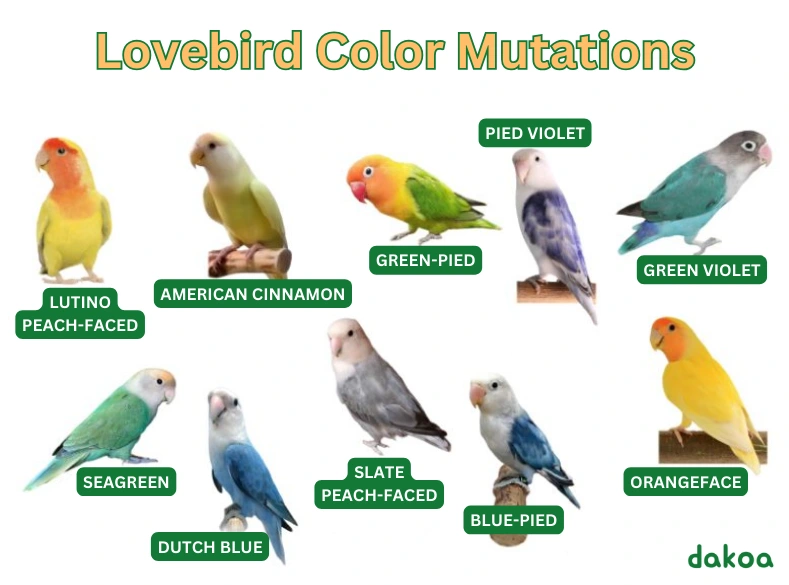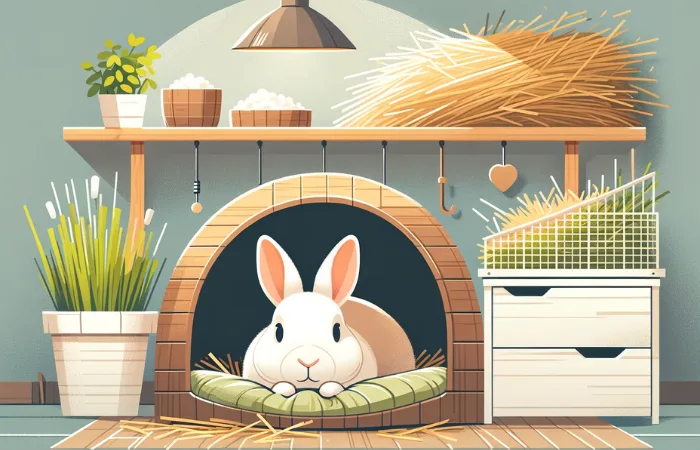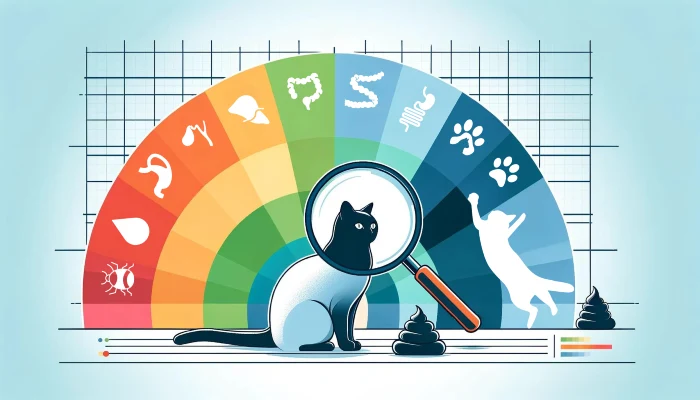Lovebirds: small in size but large in personality. These vibrant, playful parrots are a favorite among bird enthusiasts, offering a unique blend of companionship, intelligence, and beauty. But is a lovebird the right pet for you? This question deserves careful consideration, as these charming birds require specific care and attention to thrive.
Unraveling the World of Lovebirds
Are you considering the addition of a feathered friend to your family? Understanding the unique needs and behaviors of lovebirds is essential before making this commitment. From their social nature to their dietary preferences, lovebirds aren’t just pets; they’re companions that will become an integral part of your daily life.
In this article, you’ll learn:
- What you need to create a nurturing environment for your lovebird.
- The importance of a balanced diet and how to meet your bird's nutritional needs.
- Training and enrichment to keep your lovebird mentally stimulated and happy.
Embark on this journey with us as we dive into the captivating world of lovebirds, equipping you with all the knowledge you need to care for these delightful creatures.
What to Expect from a Lovebird
Before you run out and get yourself a lovebird, you should know what you’re getting yourself into, for both your sakes. Lovebirds are incredible pets, but you must be the right type of pet owner. In short, your personalities must mesh! With that in mind, let’s discuss your expectations of having a pet lovebird.
Have you ever considered sharing your home with a lovebird, a pocket-sized parrot with a personality as vibrant as its plumage? Lovebirds aren’t just captivating creatures; they’re a bundle of feathers filled with affection, energy, and charisma. But, as with any pet, there’s much to consider before you welcome one of these feathered friends into your life.
Character & Temperament
At their best, lovebirds are playful, active, and exceedingly social. They thrive on interaction and, once a bond is formed, they can be incredibly engaging companions. Imagine a tiny friend who eagerly awaits your return, ready to chirp and chatter about their day. However, it’s not all sunshine and serenades. These birds can be noisy, particularly in the mornings and evenings, filling your space with their unique vocalizations.
Each lovebird carries its own unique personality. Some are bold, embarking on adventurous escapades around your home, while others are more cautious, observing the world from the safety of their perch. Despite their generally non-aggressive nature, lovebirds can be nippy, especially if frightened or mishandled. They require consistent, positive reinforcement training to bring out their best selves.
Advantages as Pets
Lovebirds are ideal for smaller living spaces, measuring just 5–7 inches. They don’t need large cages or elaborate setups, making them more affordable and easier to care for compared to larger parrot species. Their long lifespan of 10–15 years also means you’ll have ample time to develop a deep and meaningful bond.
Disadvantages & Challenges
However, lovebirds demand your time and attention. They need daily interaction and supervision outside their cage to remain happy and healthy. Their vocal nature might be a challenge, especially if you prefer a quieter environment. Also, these birds are prone to boredom and loneliness if not provided with adequate stimulation, requiring a collection of toys and activities to keep them entertained.
Color Mutations
Interestingly, lovebirds come in a variety of color mutations. For instance, greens and blues, whites and lutinos, and peaches and yellows. We’re going to dig into this in greater detail below, but, here’s a quick graphic to give you an idea of the extraordinary variety available.
Choosing the Right Lovebird Species
In the world of lovebirds, diversity is key. With nine distinct species, each flaunting its own charm and personality quirks, the choice can be both exciting and daunting. Here, we’ll explore the most popular species, guiding you towards making an informed decision that aligns with your lifestyle and preferences.
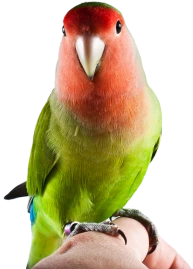
Peach-Faced Lovebird (Agapornis roseicollis)
The Peach-Faced Lovebird, with its vivid colors and outgoing nature, is often the poster bird for the species. Known for their playfulness and social disposition, they form strong bonds with their owners. If you’re seeking a lovebird that’s interactive and enjoys learning tricks, a Peach-Faced might just be your match. However, remember, their energetic nature means they require ample playtime and engagement.
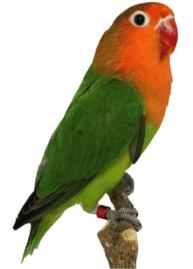
Fischer's Lovebird (Agapornis fischeri)
A bit more reserved than their Peach-Faced cousins, Fischer’s Lovebirds are known for their stunning green, orange, and blue hues. They may take a bit longer to warm up to new people, but once they do, they’re loyal and affectionate pets. Ideal for those who appreciate a more laid-back companion, Fischer’s can still be vivacious and playful in the right setting.
Masked Lovebird (Agapornis personatus)
Masked Lovebirds, with their striking black ‘masks’, are a sight to behold. They’re known for their curious and inquisitive nature. If you enjoy a pet that’s always exploring and getting into harmless mischief, a Masked Lovebird could be your perfect companion. But be warned, they can be quite the little escape artists!

Choosing a Healthy Bird
Regardless of the species, choosing a healthy lovebird is crucial. Look for bright, clear eyes, clean nares (nostrils), clean feathers, and active, alert behavior. Avoid birds that appear lethargic, have ruffled feathers, or show signs of respiratory distress.
Lovebirds aren’t just pets; they’re characters in their own right. Take, for example, a Fischer’s Lovebird named Ziggy who developed a fascination with untying shoelaces. His owner would often find him diligently working at unfastening knots, a testament to the playful and inquisitive nature of these birds.
Caring for a lovebird involves more than just providing food and water; it’s about creating a nurturing environment that caters to their physical and emotional needs.
Housing and Environment: Creating the Perfect Home for Your Lovebird
Creating a comfortable and stimulating environment is crucial for the well-being of your lovebird. This section delves into all aspects of housing and environmental needs, ensuring your feathered companion thrives in your care.
Choosing the Right Cage
Selecting the appropriate cage is the first step in creating a nurturing home for your lovebird. The cage should be spacious enough to allow your bird to spread its wings and move around freely. A general guideline is a cage that is at least 24 inches wide, 18 inches deep, and 24 inches high for a pair of lovebirds and 18 inches wide, 18 inches deep, and 18 inches high for a single lovebird. Opt for cages with horizontal bars to facilitate climbing and exercise, and be sure the bar spacing is no more than ½ inch. As with most birds, go for the largest cage you can afford that fits within your space – give your new pet the ultimate gift of spaciousness!
Location of the Cage
The placement of the cage significantly impacts your lovebird’s quality of life. Position the cage in a room where the family spends a lot of time, like a living room, to foster social interaction. However, ensure it’s not in a high-traffic area where the bird might be constantly disturbed. Keep the cage away from direct sunlight, drafts, and kitchen fumes.
Inside the Cage: Perches and Toys
A variety of perches of different thicknesses and materials, like natural wood, rope, or BPA-free plastic, should be provided to promote foot health and prevent arthritis. Toys are essential for mental stimulation and to satisfy the bird’s natural urge to chew and explore. Include foraging toys, swings, ladders, and bells to keep your lovebird entertained and engaged.
Safe and Comfortable Bedding
The cage floor should be lined with safe, easy-to-clean bedding. Paper-based bedding or newspaper is recommended, as it’s easy to monitor the bird’s droppings for any health issues. Avoid using materials like cedar or pine shavings, as their oils can be harmful to birds.
Cleaning and Maintenance
Regular cleaning is essential to prevent the buildup of bacteria and maintain a hygienic environment. Daily cleaning tasks include changing the bedding, washing food and water dishes, and removing any soiled toys or perches. A thorough weekly cleaning of the entire cage with bird-safe disinfectants is also recommended.
Temperature and Humidity
Lovebirds thrive in a stable environment. The room temperature should be kept between 70-80°F (18-27°C), avoiding sudden temperature changes. Humidity levels should mimic their natural habitat, so consider using a humidifier in dry climates.
Ensuring Safety
Bird-proofing your home is important for times when your lovebird is out of the cage. Remove toxic plants, secure windows and doors, cover water bodies, and ensure there are no small, ingestible objects within reach.
Creating a Routine
Lovebirds appreciate routine, as it provides a sense of security. Establish and maintain a consistent schedule for feeding, playtime, and rest. This helps your bird feel more secure and comfortable in its environment.
Feeding and Nutrition: Nourishing Your Lovebird for Optimal Health
A balanced diet is critical for your lovebird’s health and longevity. This section provides an in-depth guide to feeding your lovebird, including what foods are beneficial and which ones to avoid.
Lovebirds need a variety of foods to meet their nutritional needs. A balanced diet includes high-quality pellets or seed blend for small parrots, fresh fruits and vegetables, and occasional seeds and nuts. Pelleted diets are a great option, they’re nutritionally complete, no seed hull mess, and it prevents your lovebird from only choosing their favorite seeds so in turn less seed waste. It’s important to know if you get a bird that is already eating a seed diet that you introduce the pellets and reduce the seed blend slowly, to ensure that your bird is eating the pellets, birds have a high metabolism and can’t go long periods without food. Ask an avian vet or bird breeder for help to ensure that the transition from seeds to pellets goes smoothly.
Safe Fruits and Vegetables
Fresh produce is essential for providing vitamins and minerals. Safe options include:
- Apples (seeds removed)
- Bananas
- Berries
- Broccoli
- Carrots
- Cooked Sweet Potatoes
- Green Beans
- Leafy greens like spinach and kale
- Peas
Always wash fruits and vegetables thoroughly to remove pesticides and cut them into manageable pieces.
Protein Sources
Occasionally, you can offer small amounts of cooked eggs or lean meats like chicken. These should be given sparingly as treats.
Grains and Seeds
Cooked brown rice, quinoa, and barley can be offered in moderation. While seeds are a lovebird favorite, they are high in fat and should only be a small part of the diet.
Unsafe Foods and Toxins
Certain foods can be harmful to lovebirds and should be avoided:
- Alcohol
- Avocado
- Caffeine
- Chocolate
- Fruit Seeds and Pits
- Garlic
- Mushrooms
- Onion
Water
Fresh, clean water should be available at all times. Change the water daily to prevent bacterial growth.
Feeding Schedule
Consistency is key. Feed your lovebird at the same times each day and remove any uneaten fresh food after a few hours to prevent spoilage.
Monitoring Diet and Health
Keep an eye on your lovebird’s eating habits and weight. Sudden changes can indicate health issues. Regularly consult with your veterinarian to ensure your bird’s dietary needs are being met.
Enrichment Through Food
Use feeding time as an opportunity for enrichment. Foraging toys and puzzles that require your lovebird to work for their food can provide mental stimulation and mimic natural behaviors.
By providing a balanced and varied diet, you ensure your lovebird receives the necessary nutrition for a healthy and active life. Regularly reviewing and adjusting their diet with the guidance of a veterinarian will contribute to their overall well-being.
Healthcare and Hygiene: Maintaining Your Lovebird’s Health and Cleanliness
Proper healthcare and hygiene are pivotal in ensuring your lovebird leads a healthy and comfortable life. This comprehensive guide covers everything from grooming to recognizing symptoms of common health issues.
Regular Veterinary Visits
Regular check-ups with an avian veterinarian are crucial for preventative healthcare. These visits can help identify and address potential health issues early on. Your vet can also provide advice on diet, behavior, and general care.
Grooming Essentials
- Feather Care: Regular preening is natural for lovebirds. Providing a clean and safe environment helps maintain healthy feathers. Watch for excessive plucking or bald spots, as these can indicate stress or health problems.
- Beak and Nail Care: Lovebirds naturally keep their beak and nails trimmed through chewing and climbing. However, if you notice overgrowth, seek veterinary advice for safe trimming.
- Wing Trimming: Consider discussing wing trimming with your vet. It can prevent escape or injury in domestic environments, but should be done by a professional to avoid harm.
Bathing and Cleanliness
Lovebirds often enjoy bathing, and it’s good for feather health. Offer a shallow dish of water a couple of times a week for them to bathe in. Always use lukewarm water and ensure they can easily get in and out of the dish.
Common Health Issues
- Respiratory Problems: Symptoms like sneezing, nasal discharge, and labored breathing need immediate veterinary attention.
- Digestive Issues: Changes in droppings, loss of appetite, or regurgitation can signal digestive problems.
- Feather Disorders: Over-preening, plucking, or bald patches can be due to stress, dietary deficiencies, or medical conditions.
Recognizing Symptoms of Illness
Early detection is key in treating health issues effectively. Be vigilant for changes in behavior, appetite, droppings, or physical appearance. Lethargy, aggression, or changes in vocalization can also be warning signs.
Environmental Hygiene
Keep the cage and its surroundings clean. Regularly clean and disinfect the cage, perches, and toys. Avoid harsh chemicals; use bird-safe disinfectants instead. Ensure fresh food and water are provided daily to prevent contamination.
Stress Reduction for Health
Minimize stress as it can lead to health problems. Maintain a consistent routine, provide a comfortable and enriching environment, and give your lovebird attention and social interaction.
By adhering to these healthcare and hygiene practices, you can significantly contribute to your lovebird’s overall health and happiness. Consistent care, along with being attentive to your bird’s habits and needs, will ensure they remain a vibrant and joyful companion.
Training and Enrichment: Engaging Your Lovebird's Mind and Strengthening Your Bond
Training and enrichment are crucial for your lovebird’s mental health and your bond with them. This section provides an in-depth look at various activities, games, and training tips to keep your lovebird stimulated and content.
Importance of Mental Stimulation
Lovebirds are highly intelligent and active birds that require mental stimulation to stay healthy and avoid behavioral issues like feather plucking or excessive vocalization. Engaging their minds with various activities helps satisfy their natural curiosity and playful nature.
Training Basics
- Simple Commands: Start with basic commands like ‘step up’ onto your finger or a perch by placing your finger gently on your bird’s chest as you say ‘step up’. Use gentle guidance and positive reinforcement with treats.
- Trick Training: Lovebirds can learn tricks like turning around, waving, or fetching small objects. Keep training sessions short, fun, and rewarding.
- Consistency is Key: Be consistent with your commands and rewards. Training should be a positive and stress-free experience for your lovebird.
Enrichment through Toys
- Variety of Toys: Offer a variety of toys, such as chew toys, bells, ladders, and mirrors. Toys made of safe, chewable materials like wood or natural fibers are great for beak health.
- Foraging Toys: These encourage natural foraging behavior and provide mental stimulation. Toys where they have to work to get a treat or discover hidden compartments are ideal.
- Interactive Play: Engage in play with your lovebird using toys, mimicking natural behaviors like foraging and exploring.
Preventing Boredom
- Rotate Toys Regularly: Regularly change the toys in the cage to keep the environment new and interesting.
- DIY Toys: Creating homemade toys can be a fun way to add variety. Use safe materials like paper, cardboard, or untreated wood.
Creating an Enriching Environment
- Safe Exploration Area: Allow your lovebird time outside the cage in a bird-proofed area where they can explore safely.
- Music and Sounds: Play soft music or natural sounds, which can be soothing and stimulating for lovebirds.
Benefits of Enrichment
- Enhances Bonding: Engaging in training and play helps strengthen the bond between you and your lovebird.
- Promotes Physical Health: These activities also encourage physical exercise, which is essential for your lovebird’s health.
Training and enrichment aren’t just about keeping your lovebird entertained; they’re vital for their overall well-being. By providing these opportunities, you’ll see a happier, healthier, and more engaged companion in your lovebird.
Understanding Lovebird Behavior and Social Needs
Lovebirds are social creatures and thrive on interaction. If you have a single lovebird, ensure you spend quality time daily with them. Neglect can lead to behavioral issues and depression. For those unable to provide constant companionship, please consider getting a pair.
In the wild, lovebirds are social birds, often found in small flocks. This social nature carries over in captivity. They form strong bonds with their owners or other birds. If you have a single lovebird, be prepared to become their ‘flock’, requiring significant daily interaction. For those unable to dedicate this time, it’s best to get a pair of lovebirds, as it helps prevent loneliness and behavioral issues.
Lovebirds display a variety of behaviors that are expressions of their mood and health. A happy lovebird might sing, preen, and flap its wings. Conversely, a lovebird that is stressed or unhappy may pluck its feathers, become aggressive, or retreat into a corner of the cage.
Common Misbehaviors
Chewing and nipping are common lovebird behaviors. Providing chewable toys can help mitigate unwanted chewing of furniture or belongings. Training and gentle handling from a young age can reduce nipping tendencies.
Communication
Lovebirds communicate through a range of sounds, from chirps to squawks. Paying attention to these sounds, along with their body language, can help you understand their needs and moods. A quiet, subdued lovebird might indicate illness or distress, while loud, continuous chirping often means they’re seeking attention or expressing joy.

There are feral populations of lovebirds in San Francisco, Arizona and even Texas that are birds that escaped from aviaries and private owners.
Bonding with Your Lovebird and Integration into the Family
Introducing a lovebird into your home is an exciting experience. Building a bond with your feathered friend and integrating them into your family requires patience and understanding.
The Bonding Process
Bonding with a lovebird takes time and consistency. Start by spending time near their cage each day, talking softly to them. Gradually, you can introduce your hand into the cage for short periods, offering treats to encourage interaction. Respect their space and avoid forcing contact, as trust is key in forming a bond.
Socialization
Once your lovebird starts feeling comfortable, you can begin socializing with family members. Supervise these interactions, especially with children, to ensure they’re gentle and understand how to handle the bird safely. Consistent, positive experiences with different family members can help the lovebird feel part of the household.
Creating a Safe Environment
Ensure your home is safe for your lovebird. This includes removing hazardous items they might chew on, ensuring windows and doors are secure to prevent escape, and keeping other pets at a safe distance until the lovebird is comfortable with them. Also watch ceiling fans if your lovebird is able to fly.
Handling and Playtime
Gentle handling is crucial in building trust. Use slow, calm movements and avoid sudden grabs or loud noises. Set aside dedicated playtime each day for interaction, which can include teaching tricks, playing with toys, or simply enjoying each other’s company.
Dealing with Behavioral Issues
If behavioral issues arise, such as biting or screaming, seek to understand the root cause. Often, these behaviors stem from fear, boredom, or lack of attention. Addressing the underlying issue with patience and positive reinforcement can help resolve them.
Respecting Their Individuality
Each lovebird has its own personality. Some may be cuddly and affectionate, while others might prefer less physical contact. Respecting their individual preferences will strengthen your bond and ensure a harmonious relationship.
By following these guidelines, you can create a loving and trusting relationship with your lovebird, making them a cherished member of your family.
Conclusion: Embracing the Journey with Your Lovebird
Embarking on the journey of lovebird ownership is both a delightful and a serious commitment. These vibrant birds bring joy and companionship, but they also require dedicated care and attention.
Key Takeaways
- Understanding Lovebird Needs: Recognizing the unique requirements of lovebirds, from their social nature to their specific dietary needs, is essential for their well-being.
- Bonding and Socialization: Building a bond with your lovebird involves patience, gentle interaction, and understanding their individual personality and comfort levels.
- Health and Wellness: Regular veterinary care, a balanced diet, and a safe living environment are crucial for keeping your lovebird healthy and happy.
As a new lovebird owner, your learning journey has just begun. Consider exploring more about advanced lovebird care, behavioral training, or joining a community of bird enthusiasts for support and advice.
Owning a lovebird can be a deeply rewarding experience, offering a unique blend of companionship, beauty, and interaction. By providing the right care and building a strong bond, you’ll enjoy a fulfilling relationship with your feathered friend for years to come.
Lovebirds FAQ
Are male or female lovebirds friendlier?
Female lovebirds tend to be more territorial and are more likely to bite, where male lovebirds are gentler and less likely to bite.
Can lovebirds learn to talk?
Lovebirds don’t tend to talk, but they can learn some simple words and easy phrases if they are taught with consistent repetition from a young age.









